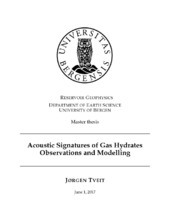| dc.description.abstract | Interpretation of a Bottom Simulating Reflector (BSR) associated with gas hydrate accumulations in seismic, depend on gas hydrate saturation and distribution in pore voids. The BSR cannot predict gas hydrate saturation or distribution in pore voids. Hence, forward rock physics techniques are extensively used to quantify gas hydrate accumulations. This thesis work utilize rock physics and seismic modelling to observe the seismic response of different gas hydrate saturations and distributions. Detection and mapping of gas hydrates are important because of: their energy potential, role as a geo-hazard, and effect on the global climate change. It is important to develop an understanding related to gas hydrate distribution in sediments. In order to prevent slope instabilities, release of greenhouse gases into oceans/atmosphere, and potentially producing methane gas for energy consumption. Three pore-void distribution schemes are proposed, where gas hydrates, 1) cement grains at grain-contact, 2) cement entire grains, and 3) are deposited away from grain-contact. Scheme 1) and 2) have been related to major increase in sediment stiffness, while scheme 3) display little or no effect. Gas hydrates have been encountered where no BSR reflection is observed in seismic, which means that the BSR has limitations associated with small gas hydrate saturations. Different cases are outlined in this study, in order to look at both gas hydrate and free gas effect on the BSR. Free gas have a great impact on seismic reflections, because it decrease the P-wave velocity of sediments greatly. For smaller gas hydrate saturations the study reveals that free gas make the greatest contribution to the observed BSR reflection. For gas hydrates cementing grains at higher saturations, the increased sediment stiffness result in a strong velocity contrast even without free gas beneath. A correlation model between gas hydrate saturation and distribution reveals that cementation of grains occur at a specific critical saturation. Synthetic seismic sections are based on the gas hydrate system at the Storegga slide area outside the mid-Norwegian margin. Comparison with real seismic data, reveals that the observed BSR at this area mainly arise from free gas situated below the BSR. Results in this thesis sheds light on the importance of understanding gas hydrate formation and distribution in sediments, to better interpret the BSR. | en_US |
